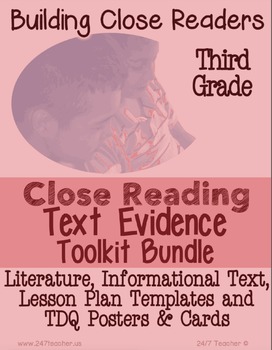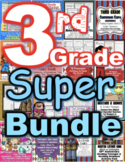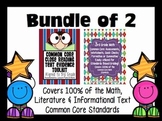3rd Grade Interactive Notebook: Tools for Close Reading, Assessment & Response
- PDF
- Google Apps™
- Easel Activity

Also included in
- This is a bundle of our 5 top selling 5 STAR Rating Common Core Toolkits for Close Reading available to save money and obtain our top Common Core Toolkits. Shifting into Close Reading is happening in classrooms across the U.S. Use the respective tools in this unit for implementation of common core sPrice $44.80Original Price $75.00Save $30.20
- 16 Resources ALL 5 STARS all your 3rd Grade Needs!!!PLEASE CLICK ON EACH RESOURCE TO SEE PREVIEWS BEFORE PURCHASINGAll units Common Core Aligned.Whole year instruction including summer review unit.Questions, Click here to contact "247Teacher".Price $91.25Original Price $162.94Save $71.69
- "When our District was between adoptions, I had a difficult time finding appropriate resources to support my students' mastery of the Common Core Standards while still keeping them engaged. These resource provided me with just what I needed! I was able to find reading selections, both literature aPrice $18.00Original Price $25.00Save $7.00
- This 3 pack Bundle contains 2 Interactive Toolkit Notebooks and a 340+ Page Close Reading Unit. All 5 STARS Click to preview:-3rd Grade Common Core: Tools for Interactive Reading Notebook 100% Aligned -3rd Grade Interactive Notebook: Tools for Close Reading, Assessment & Response-3rd Grade 40 CPrice $22.40Original Price $40.00Save $17.60
Description
Celebrate Close Reading with this unit! Inside you will find text based question cards, bookmarks, text coding supports, posters, graphic organizers, discussion tools and lesson plan templates. Each of the above are aligned to Literature and Informational Text Common Core State Standard.
• • Anchor Charts and Binder Tools • •
• • Close Reading Rationale and Information • •
-- Informational Text Standards and Getting Started Ideas
>> Key Ideas and Details First Reading Day One
>> Craft and Structure Second Reading Day Two
>> Integration of Knowledge and Ideas Third Reading Day Three
>> Text Based Question Posters and Cards.
>> Text Coding Bookmarks for each reading.
>> Close Reading Bookmarks for each reading.
-- Literature Supplements for CCSS and Getting Started Ideas
>> Key Ideas and Details First Reading Day One
>> Craft and Structure Second Reading Day Two
>> Integration of Knowledge and Ideas Third Reading Day Three
>> Text Based Question Posters and Cards.
>> Text Coding Bookmarks for each reading.
>> Close Reading Bookmarks for each reading.
Lesson Plan Templates
Discussion Tools
Literature Graphic Organizers
Informational Text Graphic Organizers
In an effort to help with setup, black & white versions for everything colored are included.
The tools presented in this toolkit address the following CCSS skills.
Literature
- RL.3.1 Asking and Answering Questions
- RL.3.2 Genres: Folktales, Fables, and Myths with morals and lessons. * Retelling and recounting stories.
- RL.3.3 Describing characters with specific differentiation for feelings and traits.
- RL.3.4 Using context clues. Literal and Non-literal foldables to focus on idioms
- RL.3.5 Refer to stories, dramas and poems
- RL.3.6 Point of view and perspective
- RL.3.7 Illustrations: To focus on the mood, setting, details and characters.
- RL.3.9 Compare and contrast also with specific focuses on theme and plot
- RL.3.10 Comprehension with tools to record literature.
Informational Text
- RI.3.1 Ask and Answer Questions to cite text evidence with text dependent questions.
- RI.3.2 Main Idea and details to focus on citing evidence to prove the main idea using details to include stated and implied main ideas also with factual and sensory details.
- RI.3.3 Focus on types of texts to include historical, scientific and technical
- RI.3.4 Words and phrases to include context clues, dictionary and strategies.
- RI.3.5 Text features to focus on three types of features such as navigators, types of print and visual features.
- RI.3.6 Point of view demonstrating differentiation between the author and the reader.
- RI.3.7 Illustrations to include photographs, maps and diagrams
- RI.3.8 Text Structure with focus on Compare & Contrast, Cause & Effect and Sequence.
- RI.3.9 Compare and contrast main points and key details
- RI.3.10 Informational Text comprehension
PDF available even without a Google Account. Upon purchase,
Email me at 247teacherfile@gmail.com and receive within 24 hours.
********PDF (Original) with Google™ PDF Link Included:
You have Full Permission to Modify for your students. It’s yours- ENJOY!
You are free to create a Google Slides, Doc, etc. or use and modify it with ANY other digital platform. Questions: jharrod@247teacher.us
Click here to see my Fourth Grade Close Reading Toolkit!
Click here TO GET ALL 5 STAR RATING READING TOOLKITS DISCOUNTED BUNDLE!
Original works of
© 24/7 Teacher LLC
Please ask any and all questions prior to purchasing at www.247teacher.us.
For more on Text Coding, Text Structures, and Close Reading of Informational Texts.
Click HERE to see my Interactive Notebook for Informational Text, Text Structures, and Close Reads.
___________________________________________________________________
Click HERE to see my Monthly Close Reading Units.
"Helping your children become text-dependent!"
Each monthly unit has history, biographies, science topics, holidays, and more!
Designed for Close Reading: Other uses includehomework, social studies, or science.
Text dependent questions are designed for text evidence responses!
Each passage is written at FOURlevels.From first to fifth!
Each passage has five or more activities. Use for guided reading!
Each passage can be used as week-long homework!
Click HERE to check out my Monthly Close Reading Club!
January-December!
Click below to see more of each individual unit in the file.
Click HERE for the January Close Reading Unit. 20 passages: EACH Written at FOUR levels.
Click HERE for the February Close Reading Unit. 20 passages: EACH Written at FOUR levels.
Click HERE for the March Close Reading Unit. 20 passages: EACH Written at FOUR levels.
Click HERE for the April Close Reading Unit. 20 passages: EACH Written at FOUR levels.
Click HERE for the May Close Reading Unit. 20 passages: EACH Written at FOUR levels.
Click HERE for the June Close Reading Unit. 20 passages: EACH Written at FOUR levels.
Click HERE for the August Close Reading Unit. 10 passages: EACH Written at FOUR levels.
Click HERE for the September Close Reading Unit. 20 passages: EACH Written at FOUR levels.
Click HERE for the October Close Reading Unit. 20 passages: EACH Written at FOUR levels.
Click HERE for the November Close Reading Unit. 20 passages: EACH Written at FOUR levels.
Click HERE for the December Close Reading Unit. 20 passages: EACH Written at FOUR levels.
Click the green links to see the titles included in each unit.
___________________________________________________________________
Click HERE to follow on FB for exclusive Facebook Only FREEBIES!
Click HERE to grab some new freebies at www.247teacher.us
Click HERE to follow on Pinterest!
___________________________________________________________________
Have a question? Have a suggestion?
All informational texts are original. Literature or fiction pieces are either original pieces written by Joe Harrod or retellings by me from public domain. Original pieces are the copyrighted works of Joe Harrod, operating under the umbrella entity of 24/7 Teacher LLC.
If you have colleagues interested in my work, please respect the DMCA by directing them to my store. Your purchase is for one classroom only. Please purchase additional licenses if you intend to print for more than one classroom. Additional licenses are listed at or more than 50% off. If you have any questions please communicate with me: at www.247teacher.us!
Are you ordering three or more?
Then, please read the following.
In order to provide you with a fair and accurate quote please email: jharrod@247teacher.us for information regarding pricing for team, grade level, school site, or district licenses.
All rights reserved by J. Harrod. This product may not be distributed digitally such as through any usb flash drive or mass storage device. Under no circumstance can this product be uploaded to any cyber sharing platform such as a server, drive, network, wiki, or digital cloud storage unless approved by 247 Teacher LLC. Failure to comply is a copyright infringement and a direct violation of the Digital Millennium Copyright Act (DMCA).
Thank you for recognizing my hard work and directing your colleagues to my store.










